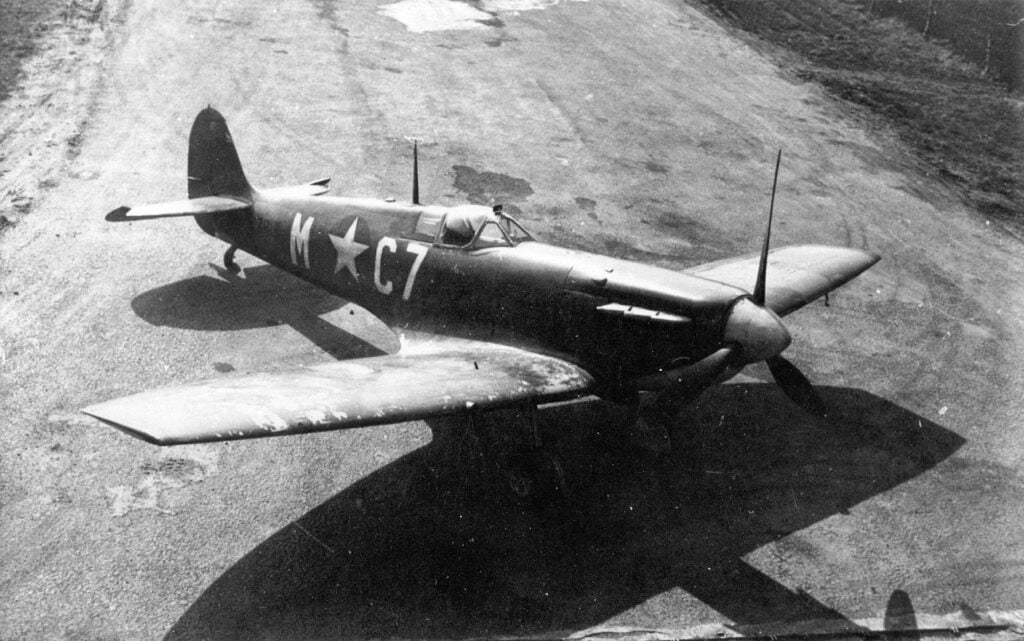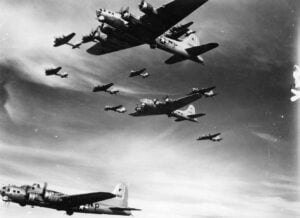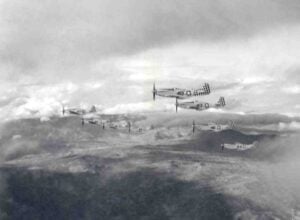The Forbidden Propeller Trick That Allowed Pilots to Outspeed the Bf-109 in WWII

United States Army Air Forces, Public domain, via Wikimedia Commons
A High-Altitude Encounter
April 22nd, 1943. At 12,000 feet above the Bay of Biscay, the air was thin and sharp, making every breath feel strained through a pilot’s oxygen mask. Flight Lieutenant James Jock Morrison guided his Supermarine Spitfire MK V through the pale morning sky, its Merlin engine humming steadily beneath him. Below, the Atlantic shimmered like broken silver under the sun. The calm was deceptive. Far on the horizon, a faint glint appeared, growing into four approaching German Bf-109 fighters, their sleek fuselages and pointed noses unmistakable.
Morrison knew the odds. On paper, the Bf-109 had the advantage, especially at low altitudes, with a propeller and engine combination designed for quick bursts of speed and rapid acceleration. Even at this height, the German fighters were faster and more efficient in short attacks. Turning back was not an option, as retreat would expose unescorted RAF reconnaissance aircraft to immediate danger. He focused on the instruments in front of him, steadying his pulse, aware that survival required more than training—it required innovation.

A Dangerous Experiment
Morrison had a secret few pilots knew about. It was a modification to the Spitfire’s constant-speed propeller system, an adjustment not officially approved and capable of damaging the engine if mishandled. By overriding the propeller governor, the system allowed the Merlin engine to push the blades beyond their standard pitch, providing a small but crucial boost in thrust. Mechanics called it risky, pilots whispered it was suicidal, but Morrison had tested it once and understood its potential.
As the German fighters closed in, he activated the hidden switch. The engine’s sound deepened into a raw roar, and the Spitfire surged forward, pressed by both propeller and gravity. The sudden speed increase caught the enemy off guard. Their formation wavered, confused by a British fighter gaining on them where it should have been slower. Morrison felt the aircraft tremble, the Merlin engine straining beyond recommended limits, but the advantage was immediate. The Bf-109s lost ground, eventually disappearing from view, leaving Morrison alone in a sky temporarily tilted in his favor.

The Cost of Extra Speed
While the maneuver worked, the price became apparent almost immediately. Thin trails of vapor formed near the engine cowling, and the temperature gauge climbed steadily. The metallic smell of overheating oil filled the cockpit, and a faint clatter under the engine warned Morrison that the Merlin was under extreme stress. He had to balance speed and safety, gradually easing the throttle to allow the blades to return to their normal pitch. The engine’s roar softened, though it remained hot and strained. He had outrun the enemy, but now he was racing against the limits of his own aircraft.
Despite the danger, the success of the forbidden propeller adjustment would not be forgotten. Mechanics began discussing the modification in hushed tones, and pilots experimented with it cautiously during missions. While command officially ignored it, the technique spread across squadrons, giving British fighters occasional bursts of speed they were not supposed to have. Soon, German pilots noticed the shift. Allied aircraft that should have been slower were suddenly capable of outrunning Bf-109s in unexpected situations

Ripples Across the Air War
The moment highlighted how small, unofficial innovations could change the dynamics of air combat. Morrison’s adjustment relied on precise timing, careful control, and a willingness to risk engine failure. Yet it allowed pilots to gain extra seconds and meters of speed—enough to evade or regroup in the face of superior aircraft. Each flight that used the trick demonstrated that even limited technological advantage could compensate for disparities in aircraft design.
Over time, whispers of the “propeller trick” circulated, becoming part of squadron lore. Pilots shared experiences of sudden acceleration that surprised German opponents, sometimes saving lives and preserving aircraft from near-certain loss. No official reports recorded these incidents, and Morrison’s role remained unknown, but his action left a subtle yet enduring mark on the air war over Europe, showing that resourcefulness and calculated risk could create openings where raw power alone could not.



















